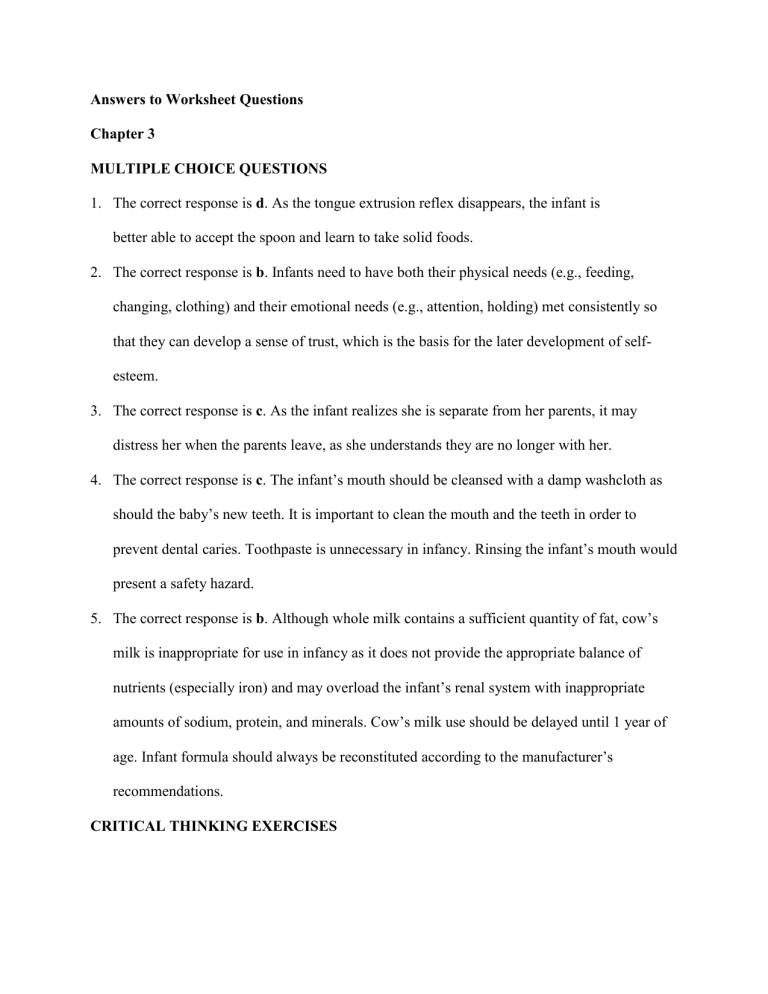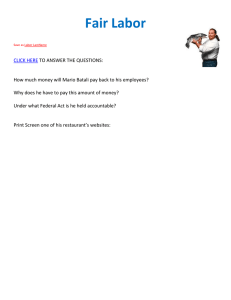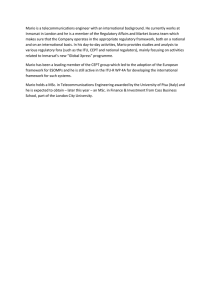
Answers to Worksheet Questions Chapter 3 MULTIPLE CHOICE QUESTIONS 1. The correct response is d. As the tongue extrusion reflex disappears, the infant is better able to accept the spoon and learn to take solid foods. 2. The correct response is b. Infants need to have both their physical needs (e.g., feeding, changing, clothing) and their emotional needs (e.g., attention, holding) met consistently so that they can develop a sense of trust, which is the basis for the later development of selfesteem. 3. The correct response is c. As the infant realizes she is separate from her parents, it may distress her when the parents leave, as she understands they are no longer with her. 4. The correct response is c. The infant’s mouth should be cleansed with a damp washcloth as should the baby’s new teeth. It is important to clean the mouth and the teeth in order to prevent dental caries. Toothpaste is unnecessary in infancy. Rinsing the infant’s mouth would present a safety hazard. 5. The correct response is b. Although whole milk contains a sufficient quantity of fat, cow’s milk is inappropriate for use in infancy as it does not provide the appropriate balance of nutrients (especially iron) and may overload the infant’s renal system with inappropriate amounts of sodium, protein, and minerals. Cow’s milk use should be delayed until 1 year of age. Infant formula should always be reconstituted according to the manufacturer’s recommendations. CRITICAL THINKING EXERCISES 1. Assessment of a premature infant’s growth and development should be based on the adjusted age rather than the chronologic age. An 11-month-old who was born at 24 weeks’ gestation (4 months early) should exhibit the growth and development of a 7-month-old infant. 2. The nurse would need to determine the frequency, consistency, characteristics, and volume of emesis; the volume and frequency of feeding; the adequacy of burping; and growth parameters. 3. Increase the frequency and decrease the volume of feedings; make sure the infant burps at least two or three times per feeding; keep the infant upright for 20 to 30 minutes after feeding; avoid placing the infant in an infant seat after feeding. If vomiting increases or becomes projectile or if the infant is failing to gain weight, notify the primary care provider. STUDY ACTIVITIES 1. The teaching plan should include appropriate information related to progression of feeding and self-feeding skills, language development, and motor skills appropriate for the 9-monthold infant. 2. The safety plan should include information on car seat safety, poisoning prevention and treatment, child safety locks and gates, water safety, and avoidance of “choke” foods. 3. Students’ answers will vary based upon the children they choose to observe. BRINGING IT ALL TOGETHER: A CASE STUDY 1. Ask Mario’s mother to provide a typical 24-hour intake recall, including number of breastfeeding sessions. Teach Mario’s mother: Infants require nutrients available in solid foods after 6 months of age. Feed Mario while he is sitting in an upright position. Introduce solid foods with a spoon. Introduce one new food, every 3 to 5 days. Foods should be pureed to a smooth consistency, whether prepackaged “baby food” or puréed at home. After Mario is taking smooth foods well, more texture will be tolerated. Soft, smashed table food without large chunks is appropriate. Finger foods such as Cheerios, soft green bean pieces, or soft peas may also be offered. Avoid hard foods that the infant may choke on. Strained, puréed, or mashed meats may be introduced at 10 to 12 months of age. Provide juice in a cup (limit to 2 to 4 ounces per day). 2. Insure that Mario has achieved the appropriate motor skills for a 9-month-old infant: Sits unsupported by 8 months, and crawls, with abdomen off floor by 9 months. Teach Mario’s mother that Mario should pull to stand and cruise by age 10 months, by 12 months sit from standing position, and walk independently at 12 to 15 months of age. Provide information to Mario’s mother about choosing a day care situation, transitioning Mario to day care, and providing breast milk when Mario is away from his mother. 3. Factors to consider when choosing a day care situation: cost and budget? sitter at home? centers should be licensed what is the caregiver to child ratio? caregivers trained in infant CPR and first aid? visit/interview with facilities prior to choosing It may help to visit the center once or twice beforehand so that Mario can get used to the caregivers from the comfort and security of the parent’s lap. Warn Mario’s mother that separation anxiety in late infancy can cause a disturbing crying episode when she leaves. Reassure her that Mario will not suffer harm due to the separation. Mario’s mother should begin pumping breast milk a couple of weeks before returning to work, in order to have frozen breast milk available for Mario when he goes to day care. Refer Mario’s mother to La Leche League International’s ‘How can I make my return to work easier?’ website at http://www.lalecheleague.org/faq/returnwork.html.


